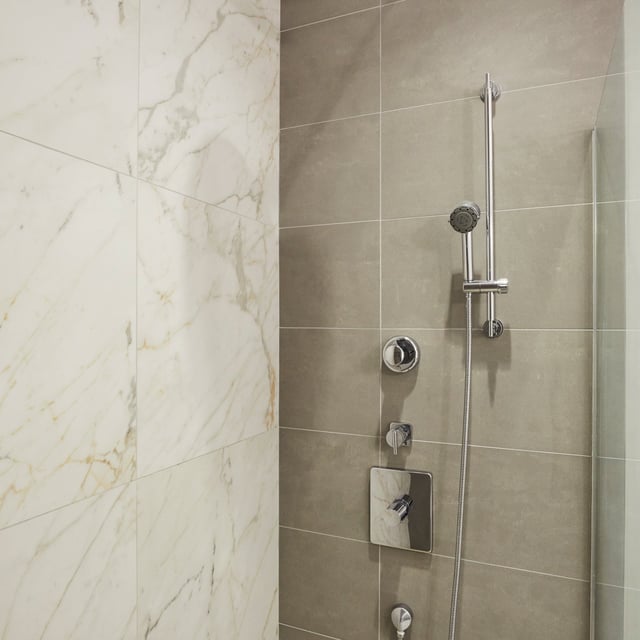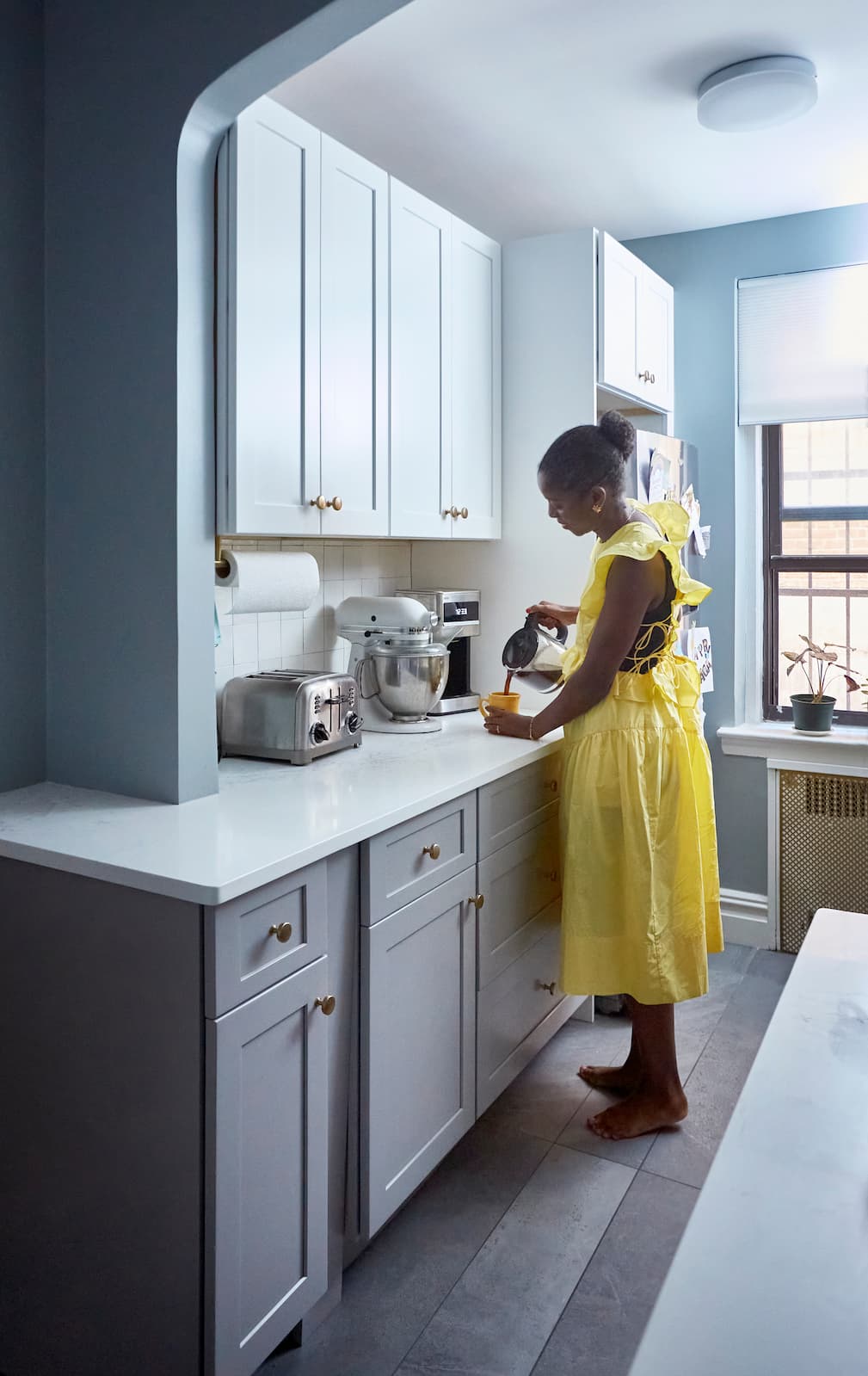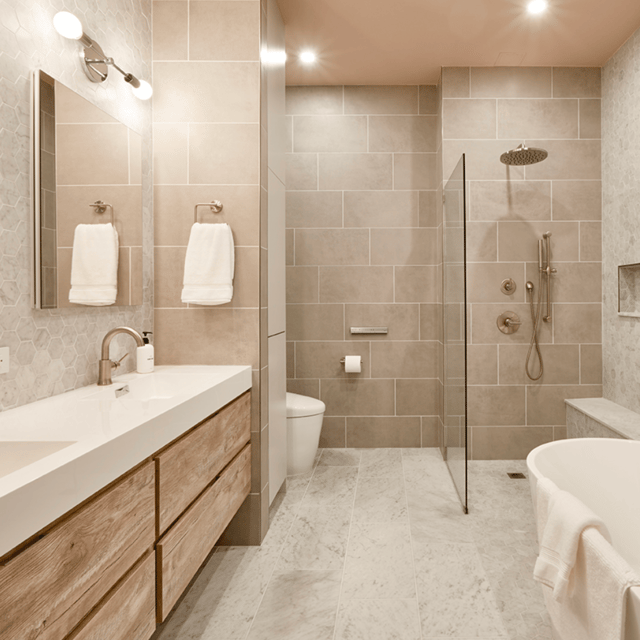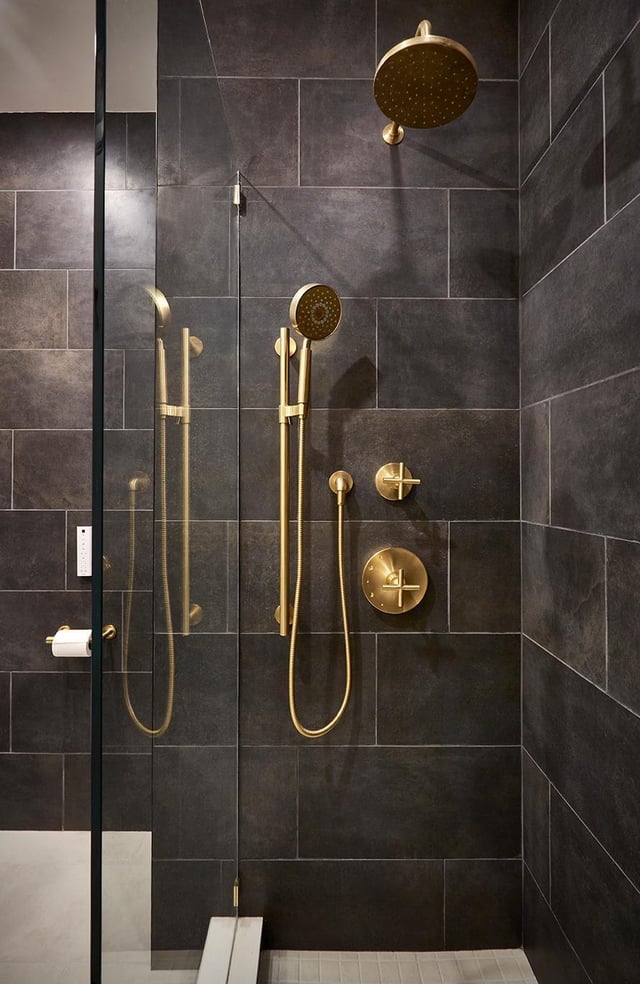
Bathroom
Eco-Friendly Shower & Bathroom Ideas
12.23.2025
Our New Year savings event is here: Get up to $6,500 off your project today (terms apply).


Natural stone isn’t the cheapest bathroom material, but it offers clear advantages: durability, distinctive character, long-term value, and finishes that age gracefully. Stone brings weight and warmth at once, grounding the room while reflecting light in ways paint never can. While types themselves can be quite varied—granite, quartz, slate, limestone, soapstone, and more—they all share a natural depth and resilience that elevates everyday use while aging with honest, lasting beauty.
This guide moves through design ideas and material choices, helping you tune the look to your habits, maintenance comfort, and budget. By the end, you’ll have a clear sense of which natural stone bathroom designs fit your space and how to bring them to life.
Large-format stone or slab walls let the stone’s organic nuances flow with minimal disruption or distraction. The eye reads longer lines and broader fields as more spacious, which visually lifts the walls and stretches the floor. Even in larger bathrooms, this restraint adds clarity and calm, making the whole composition feel intentional and elevated.
Fewer grout joints also reduce places for soap scum and mildew to collect, especially in showers. Match grout color closely to the stone and keep joints tight so seams visually recede, and enjoy the practical upside of simpler maintenance alongside the visual impact.
 See how natural stone elevates this remodeled bathroom
See how natural stone elevates this remodeled bathroom
Incorporating natural stone of varying scale makes your bathroom feel modern and interesting without making it visually “loud.” Pair generous wall panels with a mosaic floor, or set a herringbone stone on the shower pan beneath larger field tiles to create measured contrast.
Keep the palette cohesive—one stone in multiple formats or close cousins in tone—so the effect reads as texture, not clutter.
 Check out how this bathroom embraces stone
Check out how this bathroom embraces stone
Marble, granite, quartzite, or soapstone each offer different looks—some luminous, some matte, some richly grained—with durability suited to daily routines. Pair a stone top with a simple edge profile and quiet hardware to keep the focus on the surface, then echo its tones in the mirror frame or sconces. Seal thoughtfully, wipe spills promptly, and your vanity will stay in top condition for the years to come. Click here to read how natural stone countertops compare to other materials.

View how this New York bathroom incorporates natural stone
Bold veining guides the eye and defines the palette with confidence. When the veins sweep across walls or a slab-style vanity, they create a clear focal point that feels intentional and memorable. Offset this movement with restrained finishes—warm metal, clear glass, matte paint—so the pattern can unfold without competition.
 Dive deeper into this renovated New York bathroom
Dive deeper into this renovated New York bathroom
Stone’s cool clarity pairs well with the warmth of wood for balance and comfort. Real oak, walnut, or teak vanities—and wood-look porcelain where moisture is high—soften stone’s crispness and add touchable texture. Keep the tones adjacent on the spectrum—charcoal soapstone with walnut, pale limestone with white oak—to avoid visual dissonance. Finish with woven baskets, cotton towels, and a simple vase to keep the space grounded and inviting.
 See how this bathroom combines wood and natural stone
See how this bathroom combines wood and natural stone
Gray stone—think honed marble, limestone, or slate—offers a versatile base that suits many styles. Its neutrality pairs well with polished chrome, brushed nickel, black, or aged brass, and makes paint decisions straightforward. In natural light, gray shifts subtly with the day, sometimes silvery, sometimes deeper and moodier, always quietly elegant. Choose a honed finish for a velvety feel and consider a delicate contrasting grout to outline joints with clarity.
 Explore how this California bathroom uses natural stone
Explore how this California bathroom uses natural stone
High-contrast palettes create crisp, graphic bathrooms that feel clean and intentional. White marbles with inky veining or deep black stones with pale threads work well with streamlined fixtures and simple geometry. Keep accessories minimal so the stone remains the hero and the room doesn’t feel crowded. Maintain ventilation and follow sealing schedules to preserve the sharp look over time.
 See how this Brooklyn bathroom makes a strong impression
See how this Brooklyn bathroom makes a strong impression
A restrained material palette lets the stone’s texture and pattern take center stage—aligned with minimalist design traditions such as Scandinavian and Japanese. Choose wall-mounted faucets, low-profile drains, and simple hardware to reduce visual interruptions. Natural light, clear glass or doorless showers, and uncluttered surfaces will help the stone read cleanly throughout the day.
 View this luxury New York bathroom
View this luxury New York bathroom
Stone can subtly define areas like the shower, vanity, and tub without adding extra walls. Try a honed finish in wet zones for better footing and a polished finish at the vanity for a light-reflecting surface. You can also shift tile scale—mosaic for shower floors and larger tiles elsewhere—to signal function while staying cohesive. Thresholds, niche backs, and bench tops offer small opportunities to introduce a secondary stone deliberately.
 See how stone elevates this small bathroom
See how stone elevates this small bathroom
Natural stone selection blends appearance, performance, and maintenance into a single decision. While a knowledgeable designer or contractor can help you find the perfect option for your bathroom remodel, these insights might help you refine your choices.
|
Type of natural stone |
Budget |
Pros |
Cons |
|
Slate |
Low to medium |
Naturally slip-resistant texture; earthy tones; ages gracefully |
Can cleave if poorly finished; needs sealing; uneven surfaces |
|
Travertine |
Low to medium |
Warm, varied character; comfortable underfoot when honed |
Pores need filling; more maintenance in wet zones; acid-sensitive |
|
Granite |
Medium |
Dense and durable; good stain/scratch resistance; wide color range |
Some patterns feel busy; may need sealing; seams can be visible |
|
Limestone |
Medium |
Soft, matte elegance; subtle, calming colors |
Porous and softer; shows wear in high-traffic areas; sealing needed |
|
Sandstone |
Medium |
Unique grain; warm, organic presence; strong accent material |
Highly porous; frequent sealing; stains can embed without care |
|
Marble |
Medium to high |
Distinctive veining; bright, refined look; broad availability |
Etches and stains with acids; softer surface; periodic sealing |
|
Quartzite (natural) |
Medium to high |
Very hard; heat-resistant; marble-like appearance with better toughness |
Sometimes mislabeled; requires sealing; limited local color variety |
|
Soapstone |
Medium to high |
Non-porous; acid-resistant; low-maintenance counters; ages nicely |
Softer; can scratch (often repairable); limited gray-green palette |
A successful natural stone bathroom starts with a clear plan and realistic expectations for care and cost. Use Block’s Renovation Studio to visualize materials and understand pricing. When you’re ready to hire, you can share your project once and receive competitive bids from vetted contractors with expert scope review and progress-based payments. With a one-year workmanship warranty across our contractor network, you can move forward with materials that fit your life and a build process that feels clear and controlled.

Written by Block Renovation
Is natural stone considered easy to clean in bathrooms?
What is the best natural stone for shower walls?
Quartzite and dense granites perform well because they’re hard, less porous, and resist heat and scratching. Marble and limestone can be used, but they need more careful maintenance and regular sealing to prevent etching and staining. Slate is an option if it’s well-finished and sealed, though some types can cleave if poorly processed. If you want the marble look with less upkeep, consider a durable quartzite with subtle veining. For related insights, read A Guide to the Best Materials to Use on Shower Walls.
Should I choose honed or polished finishes for a natural stone bathroom?
How often does natural stone need to be sealed?

Renovate confidently with Block
Easily compare quotes from top quality contractors, and get peace of mind with warranty & price protections.
Thousands of homeowners have renovated with Block

4.5 Stars (100+)

4.7 Stars (100+)

4.5 Stars (75+)

Bathroom
Eco-Friendly Shower & Bathroom Ideas
12.23.2025

Bathroom
New York City Bathroom Remodels: Planning & Renovation Tips
12.05.2025

Bathroom
Slanted Roof Bathrooms and Shower Design Ideas
11.22.2025

Bathroom
Choosing Bathroom Fixture Finishes - Inspiration & FAQ
10.22.2025

Bathroom
Designing a 40-Square Foot Bathroom? Here’s What Actually Matters
10.22.2025
Renovate confidently